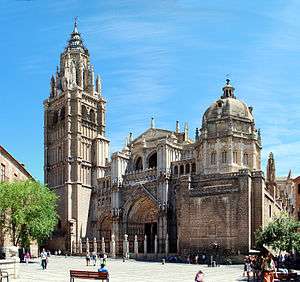Jaén Cathedral
The Assumption of the Virgin Cathedral (Spanish: Catedral de la Asunción de Jaén) is a Renaissance-style, Roman Catholic cathedral located in Santa María Square, opposite the Town Hall and the Episcopal Palace, in the center of Jaén, region of Andalusia, Spain.
| Jaén Cathedral | |
|---|---|
Spanish: Catedral de la Asunción de Jaén | |
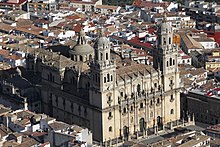 Aerial view of Jaén Cathedral. | |
| Religion | |
| Affiliation | Catholic Church |
| Year consecrated | 1660 |
| Location | |
| Location | Jaén, Spain |
| Architecture | |
| Architect(s) | Andrés de Vandelvira Juan de Aranda Salazar Eufrasio López de Rojas |
| Type | church |
| Style | Renaissance Baroque Neoclassical |
| Groundbreaking | 1249 |
| Completed | 1724 |
| Website | |
| www.catedraldejaen.org | |
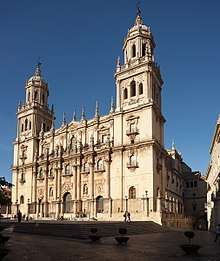
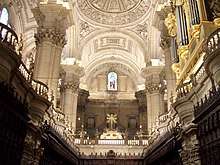
The current cathedral was conceived in the 16th century to replace the previous 15th century Gothic temple. Construction lasted for several centuries, despite the original idea was kept. The capitular room and the sacristy stand out, which are the masterpiece of Andrés de Vandelvira, and one of the most important works of the Spanish Renaissance. Also outstanding is its main facade, one of the main works of the Spanish Baroque, built after the consecration of the temple in 1660 based on the design of Eufrasio López de Rojas. Likewise, the neoclassical choir stands out due to its beauty and the large number of seats that make it one of the largest in Spain. Once the building works were completed, they continued in the following centuries, mainly in the interior decoration and the chapels. Furthermore, as a consequence of the Lisbon earthquake of 1755, consolidation works were necessary on the north facade, as well as the construction of the Sagrario church.
It is dedicated to the Assumption of the Virgin Mary since the consecration, in 1246, of the old Mosque of the Muslim city, after its conquest by the holy king Ferdinand III of Castile. Inside it, among other works of art and religious objects, the relic of the Holy Face or La Verónica , specifically the true face of Jesus Christ, which could be captured on the canvas in which Saint Veronica dried her face during his passion. It’s kept in the Main Chapel, and a public veneration of the faithful is exposed every Friday.
In 2008, the procedure for the cathedral of Jaén to be declared World Heritage Site, [1] considering that it served as a model for the construction of other cathedrals in Spain and the Americas. [2] [3][4] On January 27, 2012 the «Jaén Cathedral (extension of the Renaissance monumental complex of Úbeda and Baeza)» was inscribed on the Spanish Indicative List of World Heritage Site, in the category of cultural property (No. ref 5667). [5]
History
The cathedral stands on a site once occupied by a mosque.[6] Construction began in 1249 atop the ruins of the mosque. The church was damaged and rebuilt on numerous occasions during the following two centuries until the sixteenth century, when several architects, Andrés de Vandelvira being the most important one, built the biggest part of the cathedral. It was consecrated in 1724.
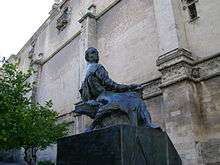
The more distinctive architectural element is its façade, designed by Eufrasio López de Rojas and sculpted by Pedro Roldán. The cathedral houses, with other artworks, a depiction of the Veil of Veronica. Around 1545 the young Francisco Guerrero was the maestro de capilla.
This cathedral is on the Tentative List of UNESCO World Heritage Sites.[6]
Church of the Sagrario

The Church of the Sagrario (Spanish: Iglesia del Sagrario) is a building attached to the north facade of the Cathedral, made due to the unevenness and damage caused by the Lisbon earthquake of 1755. The project for this work was designed by the Madrid architect Ventura Rodríguez in 1764, although it was executed by his nephew Manuel Martín Rodríguez. It was inaugurated in 1801 and was consecrated on March 22 of that year. [7]
References
- noticiascadadia.com (ed.). Catedral-de-jaen-estara-listo-en-un-ano.html "El expediente de la Catedral de Jaén estará listo en un año" Check
|url=value (help) [The file of the Jaén Cathedral will be ready in one year]. Retrieved April 14, 2009. - "Investigan qué catedrales están inspiradas en la de Jaén" [They investigate which cathedrals are inspired by that of Jaén]. Ideal. 22 January 2008.
- "La influencia de la Catedral en América es confirmada a través de documentos" [The influence of the Cathedral in America is confirmed through documents]. Ideal. 18 April 2009.
- Viva Jaén (ed.). "La influencia de la Catedral no sólo se limita a Iberoamérica" [The influence of the Cathedral is not only limited to Latin America] (in Spanish). Retrieved 19 April 2009.
- UNESCO (ed.). ""Jaén Cathedral (extension of the Renaissance Monumental Ensembles of Úbeda and Baeza)"".
- "Jaén Cathedral". UNESCO World Heritage Centre. Retrieved 11 February 2013.
- dialnet.unirioja.es (ed.). "La Decoración del sagrario de la Catedral de Jaén" [The decoration of the sagrario of the Jaén Cathedral]. Retrieved April 24, 2009.
Bibliography
- Álamo Berzosa, Guillermo (1968). "Iglesia Catedral de Jaén, Historia e imagen". Jaén, Obispado de Jaén. OCLC 16931353. Cite journal requires
|journal=(help) - Galera Andreu, Pedro Antonio (1979). La fachada de la Catedral de Jaén y la consolidación de la "arquitectura efímera". 1. Estudios sobre la literatura y arte: dedicados al profesor Emilio Orozco Díaz. pp. 523–531. ISBN 84-338-0123-6. Retrieved 1 November 2010.
- Beltrán Almazán, Cristóbal (1988). "El Cabildo de la iglesia catedral de Jaén en el siglo XVI. Organización y funcionamiento". Boletín del Instituto de Estudios Giennenses. 134: 31–58. ISSN 0561-3590. Retrieved 22 September 2011.
- Jiménez Cavallé, Pedro (1993). "La oposición al magisterio de la capilla de la Catedral de Jaén en 1711". 147. Boletín del Instituto de Estudios Giennenses: 235–253. ISSN 0561-3590. Retrieved 29 October 2010. Cite journal requires
|journal=(help)
- Herrador, Rosario Anguita (December 1994). Universidad de Jaén y Real Sociedad Económica de Amigos del País (ed.). El Arte Eucarístico: ¿un controvertido tema en el Jaén ilustrado?. Actas I Congreso 'La Ilustración y Jaén'. pp. 119–128. Archived from the original on 19 February 2012. Retrieved 25 October 2010.
(...) sagrarios y manifestadores hechos ahora en mármol, jaspe y bronce, siguiendo las recomendaciones oficiales, o en madera policromada en verde, rojo o blanco, imitando los materiales anteriores. Se pueden citer aquí los manifestadores de mármol y bronce situados en los presbiterios de la parroquia del Sagrario o de la Catedral de Jaén, y sus correspondientes sagrarios.
- Quesada Galacho, Manuel; Anta Félez, José Luis (1996). "Los exvotos en el Cristo de la Misericordia de la Catedral de Jaén". Boletín del Instituto de Estudios Giennenses. 159: 161–177. ISSN 0561-3590. Retrieved 22 September 2011.
- Navascués Palacio, Pedro; Sarthou Carreres, Carlos (1997). "Catedrales de España". Madrid: Espasa Calpe. ISBN 84-239-7645-9. OCLC 249825366. Cite journal requires
|journal=(help) - Domínguez Cubero, José (1998). "Gutierre Gierero, author del Cristo de las Misericordias de la Catedral de Jaén". Boletín del Instituto de Estudios Giennenses. 168: 43–56. ISSN 0561-3590. Retrieved 23 September 2011.
Gutierre Gierero realizó el Cristo de las Misericordias de la catedral de Jaén.
- Lara López, Emilio Luis (1999). "El friso gótico de la Catedral de Jaén: Una alegoría de la Resurrección". 172 (2). Boletín del Instituto de Estudios Giennenses: 949–977. 0561-3590. Retrieved 25 October 2010. Cite journal requires
|journal=(help)
- Galera Andreu, Pedro Antonio (2000). "La Catedral de Jaén". Úbeda (Jaén), El Olivo. OCLC 47182405. Cite journal requires
|journal=(help) - Arco Moya, Juan del (2000). "Inventario de las actas del cabildo de la catedral de Jaén en el archivo histórico diocesano". Boletín del Instituto de Estudios Giennenses. 175: 109–144. ISSN 0561-3590. Retrieved 22 September 2011.
- Barrio Moya, José Luis (2001). "Las donaciones del obispo Don Agustín Rubín de Ceballos a la Catedral de Jaén". 179. Boletín del Instituto de Estudios Giennenses: 59–67. ISSN 0561-3590. Retrieved 1 November 2010.
El obispo don Agustín Rubín de Ceballos gobernó la diócesis de Jaén desde 1780 hasta 1793. Durante aquel tiempo el generoso prelado contribuyó enormemente al embellecimiento de su sede metropolitana, costeando obras tan estimables como el retablo de San Eufrasio y el Tabernáculo del altar mayor. El hallazgo del testamento de don Agustín Rubín de Ceballos nos permite conocer que, asimismo, legó a la catedral de Jaén no sólo su biblioteca, sino también un valioso misal mozárabe toledano
Cite journal requires|journal=(help)
- Melgares Raya, José (2003). "Archivo Capitular de la Catedral de Jaén". 183. Boletín del Instituto de Estudios Giennenses: 495–510. ISSN 0561-3590. Retrieved 25 October 2010.
Existe en el Archivo Histórico Diocesano de Jaén una Sección, de singular interés, por su antigüedad, (siglo XIII) y por la importancia de su valiosa documentación. A este Archivo Capitular, entre otros documentos, pertenecen las Bulas y demás Documentos Pontificios, desde 1368; las Cartas y Privilegios Reales, desde 1525; Constituciones Capitulares y Sinodales, desde 1478; Libros Corales y Misales, a partir del siglo xv; Expedientes de Limpieza de Sangre, desde 1557 y Archivo de Música, desde Palestrina (1515-1594). Con el presente estudio hemos querido ofrecer una descripción detallada pero sucinta de la rica documentación de este Archivo.
Cite journal requires|journal=(help)
- Capel Margarito, Manuel (2004). "Un cuadro-documento de la Catedral de Jaén, pintado por Ambrosio de Valois y recuperado en Argentina". 189. Boletín del Instituto de Estudios Giennenses: 9–18. ISSN 0561-3590. Retrieved 25 October 2010. Cite journal requires
|journal=(help)
- Diario Jaén, ed. (2006). "Las joyas de la catedral". La catedral de Jaén. 1: 96. OCLC 433510473.
La catedral de Jaén está considerada la muestra más armónica del Renacimiento andaluz, hasta el punto que constituyó una auténtica referencia para las catedrales construidas en América en years posteriores. El templo, declarado Monumento Histórico-Artístico por Decreto de 3 de junio de 1931, se concibió como santuario del Santo Rostro está dedicado a la Asunción de Nuestra Señora. A pesar de ser el resultado de un largo proceso constructivo de tres siglos que abarca diversas obras y estilos, la catedral presenta una insólita unidad estilística, habida cuenta de los variados arquitectos que participaron en su construcción, de los diferentes prelados que marcaron su rumbo y de los gustos atísticos que se sucedieron a lo largo del tiempo.
Cite journal requires|journal=(help) - Galera Andreu, Pedro Antonio (2006). "Las catedrales de Vandelvira". Úbeda (Jaén), El Olivo. OCLC 309400836. Cite journal requires
|journal=(help) - Higueras Maldonado, Juan (2006). "La Catedral de Jaén: Finanzas para su construcción, durante el siglo XVII" (1). Elucidario: Seminario bio-bibliográfico Manuel Caballero Venzalá: 113–134. ISSN 1885-9658. Retrieved 3 December 2010.
datos referidos a la finanzas para construir la catedral giennense, durante el siglo XVII.
Cite journal requires|journal=(help)
- Ulierte Vázquez, María Luz de (2007). "Capillas y retablos en la catedral de Jaén". 3. Elucidario: Seminario bio-bibliográfico Manuel Caballero Venzalá: 189–208. ISSN 1885-9658. Retrieved 29 October 2010. Cite journal requires
|journal=(help)
- Lara López, Emilio Luis (2009). El friso gótico de la catedral de Jaén: una demonización de los judíos a través de la iconografía. Elucidario: Seminario bio-bibliográfico Manuel Caballero Venzalá. pp. 21–43. ISSN 1885-9658. Retrieved 4 February 2012.
| Wikimedia Commons has media related to Cathedral of Jaén. |
